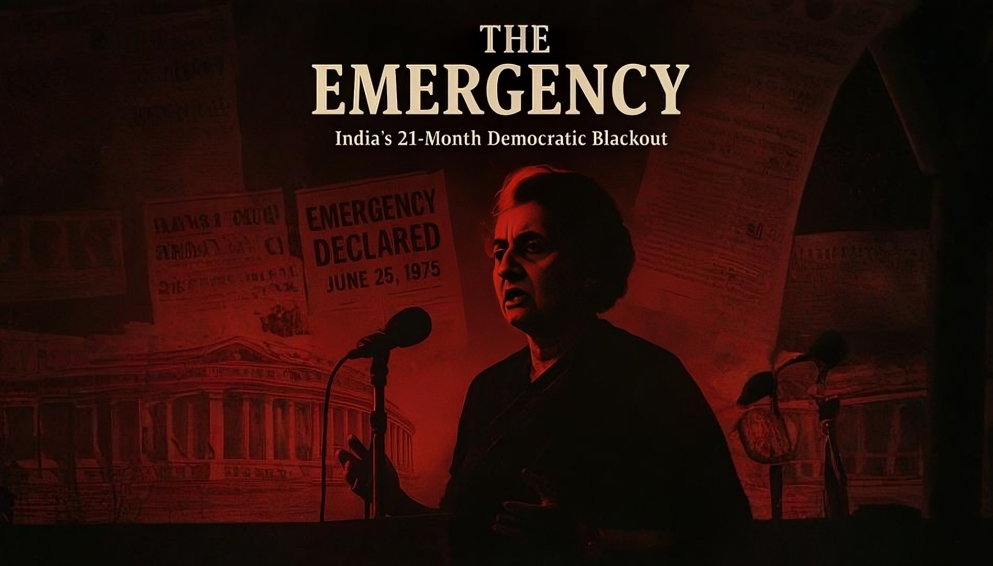Emergency
📅 Last updated: June 26, 2025 2 min read
 Why in News?
Why in News?
The year 2025 marks the 50th anniversary of one of the most significant and controversial periods in Indian democratic history — the Emergency of 1975. It was declared on June 25, 1975 by then Prime Minister Indira Gandhi, citing internal disturbance and threat to national stability.
The Emergency lasted for 21 months, during which the Constitution was effectively suspended, civil liberties were curtailed, and opposition leaders were imprisoned. Marking this, the Government of India in 2025 is commemorating the event as “Samvidhan Hatya Divas” (Constitution Murder Day).
 Why in News?
Why in News?
The year 2025 marks the 50th anniversary of one of the most significant and controversial periods in Indian democratic history — the Emergency of 1975. It was declared on June 25, 1975 by then Prime Minister Indira Gandhi, citing internal disturbance and threat to national stability.
The Emergency lasted for 21 months, during which the Constitution was effectively suspended, civil liberties were curtailed, and opposition leaders were imprisoned. Marking this, the Government of India in 2025 is commemorating the event as “Samvidhan Hatya Divas” (Constitution Murder Day).

📘 Constitutional Basis of Emergency Provisions
- Articles 352 to 360 in Part XVIII of the Indian Constitution empower the President to declare an Emergency under extraordinary circumstances.
- The aim is to provide the Union with special powers to deal with situations that threaten the integrity, sovereignty, or financial stability of the country.
- The Emergency provisions allow the Centre to override the normal distribution of powers between the Union and the States.
📂 Types of Emergency
There are three types of emergencies defined in the Constitution:
- 1. National Emergency – Article 352
- 2. President’s Rule (State Emergency) – Articles 356 & 365
- 3. Financial Emergency – Article 360
⚠️ 1. National Emergency (Article 352)
- Declared when India or any part is threatened by war, external aggression, or armed rebellion.
- The term "armed rebellion" replaced “internal disturbance” through the 44th Constitutional Amendment (1978) to prevent misuse.
- It can even be declared on the basis of apprehension of threat, not just actual occurrence.
- Must be approved by both Houses of Parliament within 30 days.
- Once approved, it remains valid for 6 months and can be extended indefinitely with repeated approvals.
- Can be revoked by the President anytime or by a simple majority in the Lok Sabha.
🧩 Effects of National Emergency
- Centre–State Relations: The Union Government gains enhanced control over states:
- Executive: Centre can issue binding directives to state governments.
- Legislative: Parliament can make laws on subjects in the State List.
- Financial: President can alter distribution of finances between Centre and States.
- Impact on Legislatures:
- Lok Sabha’s term can be extended by 1 year at a time (up to 6 months after Emergency ends).
- State Assemblies can also be similarly extended.
- Suspension of Fundamental Rights:
- Article 358: Automatically suspends rights under Article 19.
- Article 359: Other fundamental rights may also be suspended by a Presidential order.
📉 Consequences (Historical)
- Mass arrests of opposition leaders and activists without trial under MISA (Maintenance of Internal Security Act).
- Censorship of media — newspapers required prior government approval for publication.
- Forced sterilization drives under Sanjay Gandhi's population control program.
- Judiciary’s role compromised — famously in the ADM Jabalpur (Habeas Corpus) case, where fundamental rights were denied.
🏛️ 2. President’s Rule (Articles 355, 356, 357)
- Known as State Emergency, imposed when a state fails to function in accordance with constitutional provisions.
- Article 356: Used when the President, based on the Governor’s report, is convinced of failure of constitutional machinery in a state.
- Article 365: Allows imposition if a state fails to comply with directions of the Union Government.
- Must be approved by Parliament within 2 months.
- Duration: 6 months at a time, extendable up to 3 years (with conditions).
🔍 Effects of President’s Rule
- Governor runs state administration on behalf of the President.
- State Assembly may be dissolved or suspended.
- Parliament assumes power to legislate for the state.
- Used controversially in the past to dismiss elected governments — later checked by the Bommai Judgment (1994) of the Supreme Court.
💰 3. Financial Emergency (Article 360)
- Declared when the financial stability or credit of India or any part is threatened.
- Must be approved by both Houses within 2 months.
- No time limit — remains in force until revoked.
📉 Effects of Financial Emergency
- Salaries and allowances of all government employees, including judges, can be reduced.
- President’s control over state finances significantly increases.
- States may be required to reserve all Money Bills for Presidential consideration.
🧭 Conclusion
The Emergency provisions are a powerful tool meant for the survival of the Constitution and the nation in extreme situations. However, the misuse of such powers, as witnessed in 1975–77, serves as a strong reminder of the need for vigilance in a democracy.
Constitutional amendments (like the 44th) and judicial safeguards (such as the Bommai Judgment) have since tried to plug loopholes. As India marks 50 years since the 1975 Emergency, it is crucial to educate new generations about the **balance between power and liberty**, and the **importance of democratic institutions**.


